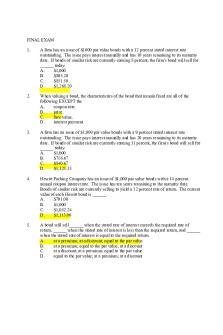Business-MATH - business math notes PDF

| Title | Business-MATH - business math notes |
|---|---|
| Course | Business Economics and Business Finance |
| Institution | Lyceum of the Philippines University |
| Pages | 3 |
| File Size | 305.9 KB |
| File Type | |
| Total Downloads | 478 |
| Total Views | 623 |
Summary
Buying and selling products•Cost refers to the amount of the retailer pays for the product he will sell to the consumers.•Net Profit is the amount of money the retailer wants to keep for and his business going.•Gross Profit is made up of the overhead or operating expenses.•Selling Price is the sum o...
Description
Mark-on based on cost Buying and selling products
• When based on cost, the mark-on is added to the cost of the item to determine the selling price as follows:
•Cost refers to the amount of the retailer pays for the product he will sell to the consumers. •Net Profit is the amount of money the retailer wants to keep for and his business going. •Gross Profit is made up of the overhead or operating expenses. •Selling Price is the sum of the cost and the gross profit. Mark-on and mark- up •Mark-on is the difference between the initial or first selling price and the cost of the item. •It is the initial or first amount added to the cost of an item to cover the operating expenses, net profit and the increase or decrease of the final adjustment. •The amount of increase from the previous selling price (cost + mark-on) to the new selling price is called MARK-UP •Mark-up is the difference between the new selling price and the initial or previous selling price.
Mark-on based on selling price • When a retailer has to purchase to replenish a merchandise whose selling price is already given, the problem is to determine the cost he shall pay for the merchandise and still have the desired rate of gross profit on the selling price. • This can be done by calculating the mark-on based on the selling price, as follows:
Mark-down •
The amount of reduction in the price of the merchandise is called markdown
Mark-up and margin Since mark-on refers to the amount added to the cost to obtain the initial selling price and the mark-up refers to the amount added to the initial selling price to get the new selling price, then they both represent the margin from the sales. The mark-up is concerned and addresses the cost of the product, while the margin is concerned and addresses the profit from sales/revenues. Trade discounts •A reduction in price of a merchandise granted by a manufacturer or a wholesaler to the retailer. •The discount can be in the form of TD (Amount of Trade Discount) or TDR (Trade Discount Rate) Mark-up •For various reasons such as scarcity or great demand for a product, inflation, increased operating expenses, influence of market forces, i.e. oil., etc., the original selling price of items has to be increased. This amount of increase in price from the old or original selling price is called MARK-UP.
•Manufacturers recommend to the retailers the price that should be charged to the customers called the List Price (LP) or suggested retail price (SRP). •The net price is the price the retailer actually pays for the merchandise.
Salary and wage Salary refers to the payment for the performance of specific duties and responsibilities. Salary can be in the form of a fixed annual amount of money paid to an employee regardless of the amount of time worked or production rendered Wage refers to a form of payment where the amount of money the employee receives is dependent on the numbers of hours rendered or the output/quantity produced. Income refers to renumeration derived from all sources such as salaries, wages, business gains, fees, rental income, commissions, dividends, interests on savings accounts, investments, etc. Computation of salaries
😊...
Similar Free PDFs

Business math worksheet
- 4 Pages

Math notes
- 3 Pages

Math Notes
- 2 Pages

Final exam thames business math
- 5 Pages

MATH 318 Lambek\'S Notes
- 138 Pages

Notes For MAth HW
- 1 Pages

Advance Math Lecture Notes
- 68 Pages

Math 131 - presentation notes
- 2 Pages

Math for nurses 2 - math notes
- 74 Pages

Med-Math-Practice 2 - math notes
- 21 Pages

MATH CME 193 NOTES
- 7 Pages

RGPS Math Revision Notes
- 81 Pages

Math 137 Course Notes
- 299 Pages

Med. Math Notes
- 6 Pages
Popular Institutions
- Tinajero National High School - Annex
- Politeknik Caltex Riau
- Yokohama City University
- SGT University
- University of Al-Qadisiyah
- Divine Word College of Vigan
- Techniek College Rotterdam
- Universidade de Santiago
- Universiti Teknologi MARA Cawangan Johor Kampus Pasir Gudang
- Poltekkes Kemenkes Yogyakarta
- Baguio City National High School
- Colegio san marcos
- preparatoria uno
- Centro de Bachillerato Tecnológico Industrial y de Servicios No. 107
- Dalian Maritime University
- Quang Trung Secondary School
- Colegio Tecnológico en Informática
- Corporación Regional de Educación Superior
- Grupo CEDVA
- Dar Al Uloom University
- Centro de Estudios Preuniversitarios de la Universidad Nacional de Ingeniería
- 上智大学
- Aakash International School, Nuna Majara
- San Felipe Neri Catholic School
- Kang Chiao International School - New Taipei City
- Misamis Occidental National High School
- Institución Educativa Escuela Normal Juan Ladrilleros
- Kolehiyo ng Pantukan
- Batanes State College
- Instituto Continental
- Sekolah Menengah Kejuruan Kesehatan Kaltara (Tarakan)
- Colegio de La Inmaculada Concepcion - Cebu

